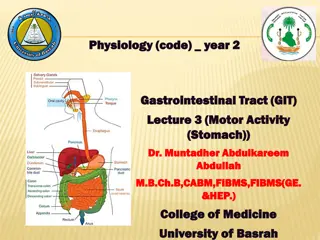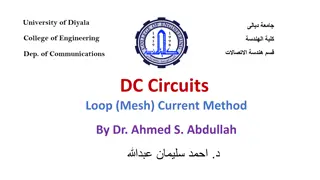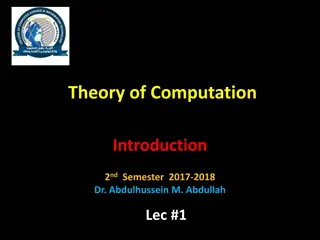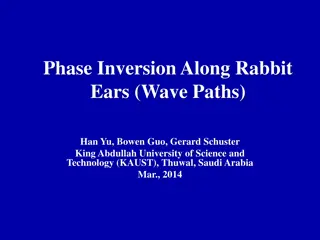Dr . Farah Qais Abdullah
This content delves into various types of research such as conceptual and empirical research, one-time versus longitudinal research, conclusion-oriented research, historical research, and more. It also discusses the difference between research methods and methodology, outlining the research process guidelines.
Download Presentation

Please find below an Image/Link to download the presentation.
The content on the website is provided AS IS for your information and personal use only. It may not be sold, licensed, or shared on other websites without obtaining consent from the author.If you encounter any issues during the download, it is possible that the publisher has removed the file from their server.
You are allowed to download the files provided on this website for personal or commercial use, subject to the condition that they are used lawfully. All files are the property of their respective owners.
The content on the website is provided AS IS for your information and personal use only. It may not be sold, licensed, or shared on other websites without obtaining consent from the author.
E N D
Presentation Transcript
Lecture 2 Dr . Farah Qais Abdullah 2019-2020
Some Other Types of Research Conceptual research / Empirical research Conceptual research: is that related to some abstract , idea(s) or theory. Empirical research : It is data-based research, coming up with conclusions which are capable of being verified by observation or experiment. We can also call it as experimental type of research.
Some Other Types of Research One-time research or longitudinal research. In the former case the research is confined to a single time-period, whereas in the latter case the research is carried on over several time-periods. Field-setting research or laboratory research or simulation research, depending upon the environment in which it is to be carried out.
Some Other Types of Research Conclusion-oriented and decision-oriented. While doing conclusion-oriented research, a researcher is free to pick up a problem, redesign the enquiry as he proceeds and is prepared to conceptualize as he wishes. Clinical or Diagnostic research: Such research follow case-study methods or in-depth approaches to reach the basic causal relations Historical research : is that which utilizes historical sources like documents, remains, etc. to study events or ideas of the past, including the philosophy of persons and groups at any remote point of time.
Research Methods versus Methodology Research methods or techniques, thus, refer to the methods the researchers use in performing research operations. Research methodology : when we talk of research methodology , we not only talk of the research methods but also consider the logic behind the methods we use in the context of our research study and explain why we are using a particular method or technique and why we are not using others so that research results are capable of being evaluated either by the researcher himself or by others.
Research Process Guideline 1. Formulating the research problem; 2. Extensive literature survey; 3. Developing the hypothesis; 4. Preparing the research design; 5. Determining sample design; 6. Collecting the data; 7. Execution of the project; 8. Analysis of data; 9- Data presentation: 10. Hypothesis testing; 11. Generalisations and interpretation, 12. Preparation of the report or presentation of the results ,i. e., formal write-up of conclusions reached.
1. Formulating the research problem There are two types of research problems, viz., those which relate to states of nature and those which relate to relationships between variables.
2. Extensive literature survey Once the problem is formulated, a brief summary of it should be written down. It is compulsory for a research worker writing a thesis for a Ph.D. degree to write a synopsis of the topic and submit it to the necessary Committee or the Research Board for approval.
3. Development of working hypotheses: After extensive literature survey, researcher should state in clear terms the working hypothesis or hypotheses. Working hypothesis is tentative assumption made in order to draw out and test its logical or empirical consequences.
4. Preparing the research design The research problem having been formulated in clear cut terms, the researcher will be required to prepare a research design, i.e., he will have to state the conceptual structure within which research would be conducted. Research purposes may be grouped into four categories, viz., (i) Exploration, (ii) Description, (iii) Diagnosis, and (iv) Experimentation.
There are several research designs, such as, experimental and hypothesis testing. Experimental designs can be either Informal designs (such as before-and-after without control, after-only before-and-after with control) Formal designs (such randomized design, design, Latin square design, simple and complex factorial designs), out of which the researcher must select one for his own project. non-experimental with control, as completely randomized block
5. Determining the sample design There are two types of sampling: 1- Probability sampling (Random Sampling): which is the best method that allows us to infer from sample drawn to the population 2- Non-Probability sampling (Non-Random Sampling).
A brief mention of the important Non-Probability sampling (Non-Random Sampling) designs as follows: 1- Systematic sampling method :by which the selection is done through a predetermined regular interval (e.g. each 3rd, each 10th, each house in the corner, etc ). 2-Quota sampling(Accidental sampling ):By market organization by interviewing and seeking of certain number of people to fit (e.g. in the street ). Although it is unsatisfactory , not representative and not generalize our finding on the population It is easy , quick , give quick results , not expensive and done in the short time. research
Random Sampling(Probability Sampling ) :- each person in the population has an equal chance to be included in the sampling as the others. So the is no Bias (the selection is biased if it systematically favors certain outcome) . This method allow us to select the sample that is a representative population , generalize our finding and only the chance factor has an effect on your sample as possible to the There are different methods of Random Sampling:
1- Simple random sampling: This type of sampling is also known as chance sampling or probability sampling where each and population has an equal chance of inclusion in the sample and each one of the possible samples, in case of finite universe, has the same probability of being selected. The first step is to draw up a list of all individuals in the population, this list is called sampling frame then coding by letters or numbers . every item in the
2- Systematic random sampling :- if the Sampling frame does not exit and we dealing with infinite population, so it is convenient to carry out sampling in systematic way(through regular interval ) the interval is determined according to total number of population and the number of the sample required ???= ????? ?????? ?? ?????????? ?????? ?? ?????? ????????
3- Stratified sampling: If the population from which a sample is to be drawn does not constitute a homogeneous group, then stratified sampling technique is applied so as to obtain a representative sample . E.g. as we have population composed of males and females, The selection of a sample that does not respect these distinct subgroups will give us a sample be totally composed of males or of females or of different percentages of males and females as that of the population . We divide the population according to the subgroups and then the simple random sampling was applied for each subgroup by epsem method(equal probability section method )or pps method(probability proportional to size)
4- Multi-stage sampling: This is a further development of the idea of stratified random sampling , when population extended over a large geographical area it is better to carry a multi-stage random sample. In this method the selection is done stage by stage and in each stage the selection is done by simple random sampling with epsem or pps method , we deal with large 5- cluster random sampling :????
Reasons for Sampling 1- Sample can be studied quickly (population needs time, money, manpower, and efforts) 2-Less expensive than studying the entire population 3-Sample results are usually more accurate than results obtained from population.
6. Collecting the data: Data can be collected by any one or more of the following ways: i. By observation ii. Through personal interview iii. Through telephone interviews iv. By mailing of questionnaires v. Through schedules
7. Execution of the project: 8. Analysis of data: Requires a number of closely related operations such as establishment of Categories Coding Editing Tabulation Analysis work after tabulation is generally based on the computation of various percentages, coefficients, etc., by applying various well defined statistical formulae.
9- Data presentation: Data is presentation is either by 1- Numerical (Numbers) 2- Tables as a- Master table b-Simple frequency distribution table. c-Class interval frequency distribution table 3- Graphs (pictorial presentation of data) when we have the data composed of small size(n=20) it is easy to present them by (numerical) "simple data", while if the data is more than 20 values or observations it is better to present them by tables.
a-Master table it is that contains all the information collected by researcher . it difficult to be understood only by the researcher him self. It contains the information regarding all variables included in the study(spread sheet in the computer Excel). b-Simple frequency distribution table. Frequency Parity 25 Primigravida(0) 14 1 16 2 18 3 27 4 & more 100 Total Table 1: the parity distribution of mothers attending ANC clinic in the PH C of Hay-AL Salam for the year 2018 Cum. f r.f c.r.f 0.25 0.39 0.55 0.73 1.00 r.f% 25% 14% 16% 18% 27% 100% c.r.f% 25% 39% 55% 73% 100% 25 39 55 73 100 - 0.25 0.14 0.16 0.18 0.27 1.00 - - The characteristics of table 1-table should be simple , easy to understood and self-explanatory. 2-Each table should have a number 3-Each table should have title written at the top of the table 4-If we use any number from any reference or book ; we should refer it at the bottom of the table
c-Class Interval frequency distribution table The data of continuous quantitative type is present her as intervals. The step to present the data by C.I tables as follows Table 2: t he haemoglobin level for 70 pregnant women in Al-Yarmouk teaching hospital for the year 2018. Hemoglobin Freq. Cum. f r.f c.r.f r.f% c.r.f% 8- 1 1 0.014 0.014 1.4% 1.4% 9- 3 4 0.043 0.057 4.3% 5.7% 10- 14 18 0.2 0.257 20.0% 25.7% 11- 19 37 0.027 0.528 27.1% 52.8% 12- 14 51 0.2 0.728 20.0% 72.8% 13- 13 64 0.186 0.914 18.6% 91.4% 14- 5 69 0.071 0.985 7.1% 98.5% 15-15.9 1 70 0.014 1.00 1.4% 100% Total 70 - 1.0 -- 100% -- 1- to present them in C.I , need to determined the K value , k=1+3.322 ?????? 2-The number of C.I(K) should not less than 5 and not more than 20 3- calculate the width W=?????(?) ? 4- Constant width; no gaps between C.I ;NO overlapping between C.I. R=(??-??)
Types of graphs 1- Bar chart
2- Pie chart 3- Scatter chart
4- Histogram It is a graphic representation used to present continuous quantitative data arranged in class-interval CI. The width of bars is very important which equal to the width of C.I .
10. Hypothesis-testing: Various tests, such as Chi square test, t- test, F-test, have been developed by statisticians for the purpose. Hypothesis-testing will result in either accepting the hypothesis or in rejecting it.
11. Generalisations and interpretation 12. Preparation of the report or the thesis



















